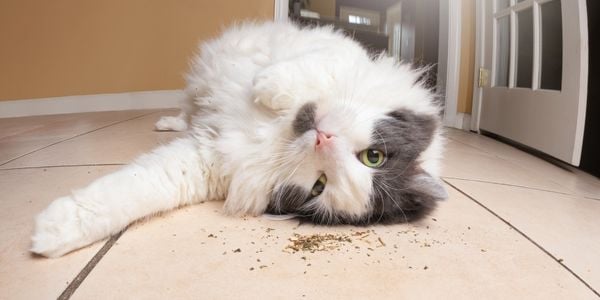
Why Do Cats Love Catnip?
Have you ever wondered why Nepeta cataria, aka catnip, is the "cat's meow"?
Cats are attracted to catnip because it contains the feline attractant nepetalactone. The plant produces nepetalactone to protect itself from herbivorous insects (I share how this benefits you later).
The roof of your cat's mouth has a "sensory device" called the vomeronasal organ. When your cat sniffs the catnip, the scent molecules are detected by the receptors of this organ, and the effects of catnip kick in. It creates an immediate and intense sense of excitement and happiness.
Essentially, it is similar to a sexual pheromone, and we all know how feline queens act in heat as well as the males when they smell them! For you to better relate, think of it as being similar to a person getting their morning coffee "high." The warmth and the aroma of the coffee are uplifting, and the caffeine supercharges the body into action. Or for those who have experienced or have seen a child on a sugar "high." Pure bliss and energy all rolled up into one moment, which is then followed by a sugar coma!
Catnip is an herb that is in the mint family and is native to parts of Asia and Europe. It has several nicknames: catmint, catswort, and catwort.
Skip to section:
Do All Cats React to Catnip?
Nearly two-thirds of cats have a hereditary trait that attracts them to catnip's nepetalactone attractant. So, why isn't catnip euphoric for all felines? Some just don't have the genes for it! It is estimated that about 30–35% of cats aren't affected by it.
Additionally, kittens generally need to be over 3 months of age (some over 6 months) before they react to catnip.
Fun Fact: Catnip doesn't just affect domestic felines. Tests have shown that other felids, such as leopards, cougars, servals, and lynxes, will also react strongly to it. Though not consistent in their response, lions and tigers may also react. Therefore, if you are hiking through the forest or are at the zoo, don't keep any in your pockets!
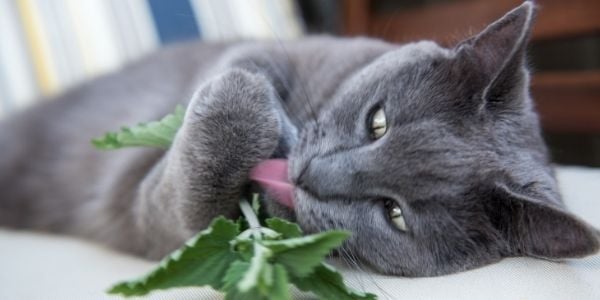
How Catnip May Affect Your Cat
When most cats are exposed to catnip and are experiencing their "catnip high" (see the video below for a "chemistry lesson"), they often rub on it, roll on the ground, lick it, chew it, and paw on it. During this time, they are often calm and content. BUT, some cats can actually become agitated, overly hyper, and potentially a little aggressive under the influence of catnip.
Typically the effects of catnip, due to olfactory fatigue (sensory overload), last between 5 to 15 minutes but can potentially have effects on some cats for up to one hour.
If your cat becomes overstimulated by too much catnip, they may become anxious, hyperactive, zoom around, nibble or bite at your hands, scratch, or growl. However, some cats may become very sleepy. If they ingest too much, they may drool, vomit or have diarrhea. That's why it's always a good idea to supervise your cat when giving them catnip, whether it is the first or hundredth time.
Giving Your Cat Catnip for the First Time
When exposing your cat to catnip for the first time, it is generally best to do a little test and see how they respond first before exposing them to more. Since the smell in most catnip toys is not very aromatic, you can let them play with a catnip toy for a minute. Another option is to sprinkle just a very small pinch of dried or fresh catnip on the floor. I recommend a little less than what's featured in the photo below. Then sit back and watch!
How Much Catnip Can You Give Your Cat?
Other than the signs mentioned above, like overstimulation and vomiting, thankfully, cats can't overdose on catnip. So, there really isn't any need to calculate how much catnip to give your cat. If you want to give catnip to your dog, then we have a calculator below to help you.
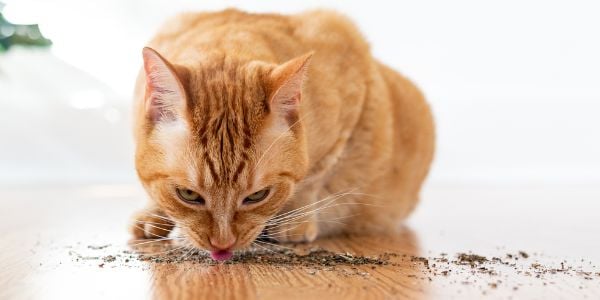 Uses for Catnip
Uses for Catnip
The typical use for catnip, especially for indoor cats, is to encourage them to play. For this, it can be great to incorporate into your environmental enrichment for your cats. However, encouraging play isn't the only use for catnip.
In some instances, cat owners have used catnip to train their cats. It may be helpful when trying to train your cat to use a scratching post instead of the sofa by sprinkling it on the post.
Given that catnip can have a calming, soothing effect, it can be used to:
- help reduce a cat's stress and anxiety when going to the vet,
- help reduce stress when traveling,
- help with urinary issues (note that stress is a major contributing factor to urinary obstruction in cats!).
Catnip As a Mosquito Repellent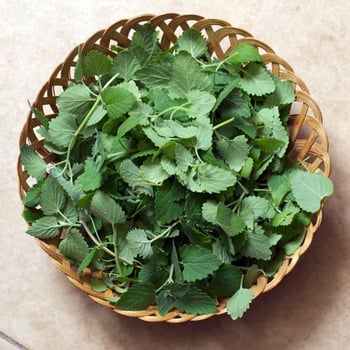
Catnip doesn't just help your cats! Apart from the calming effects of catnip (Nepeta cataria and/or silver vine) in teas and other products for humans — see my story in the next section — catnip has mosquito-repellent properties.
Planting catnip in your garden and yard can help to keep the area around your home mosquito-free! Which could greatly benefit you — both from a nuisance standpoint as well as a disease-prevention standpoint (West Nile, Zika, etc.). And since mosquitoes are how heartworm disease is spread to cats and dogs, you've got even more incentive to keep these flying pests away.
See below for our recommended safe toys, sprays, and dried catnip options that are perfect for your kitty.
See below for how to grow catnip at home.
When Catnip Can Be Dangerous
Did you know that catnip is an ingredient in some people products? Well, I didn't! But I found out quickly when my cat fell off the counter with her muzzle shoved into my box of calming herbal tea (which I needed after the event!). Fortunately, she was fine.
Catnip is used in teas, seasonings, sleep medications, etc. Be sure to check the ingredients of any natural or herbal remedies you may use. If they contain catnip (Nepeta cataria) and/or silver vine, be sure to lock them away safely from your cats. Not only are they at risk of falling, as mine did, but those products may also contain other ingredients that may be toxic to your cat.
Does Catnip Affect Dogs?
Since all of Nepeta cataria nicknames reference cats, does it have any effects on dogs? Many households have both cats and dogs (if the cat says it is ok), so knowing the answer to this question is important.
Catnip, when in moderation, is safe for dogs and can actually be beneficial to them. Since catnip is a plant, it is made up of different elements that can benefit your dog. It contains vitamins, minerals, flavonoids, tannins, and oils.
With that said, do not give your dog catnip cat toys. This can result in choking or a potential intestinal obstruction.
Catnip has been found to have a sedative effect on dogs. However, this only occurs when they eat it, and a little goes a LONG way. Unfortunately, it is hard to predict its effects. Additionally, some dogs can become hyperactive instead of sedate.
Catnip has been found to help some dogs with indigestion, cramps, diarrhea, and gas. Again, only a small amount is needed.
How Much Catnip Can You Give Your Dog?
The average dose is 1/8 tsp to ½ tsp of dried catnip per kilogram of your dog's body weight (1 kilogram = 2.2 pounds). Use the calculator below to figure out how much catnip your dog should get. Always start at the lower end of the range since your dog's reaction cannot be predicted.
For example, if your dog weighs 30 pounds (13.61 kgs), divide 13.61 by 8 = 1.7 teaspoons for the low range of catnip. For the high range, divide 13.61 by 2 = 6.8 teaspoons. So, a 30 lbs dog would get between 1.7 and 6.8 teaspoons of catnip.
Safe Catnip Toys and Sprays
First of all, catnip should be stored in an airtight container, kept in the dark, and out of your cat's reach. The freshness and lifespan of catnip are diminished by heat, sunlight, and freezing since they can break down the oils.
Other than the fact that fresh catnip is more potent than dried catnip, there is no difference. However, some cats have a preference for one over the other.
Note: I would recommend using sources that are non-GMO and organically grown. All catnip options provided below are grown in the USA unless stated otherwise, and some are organic.
Different Ways You Can Provide Your Cat With Catnip
- Grow your own plant from seeds: This option doesn't work for those folks who don't have adequate sunlight or a green thumb! See below for growing tips.
- Buy a plant: It will need to be put in a spot that gets 5–6 hours of direct sunlight a day. You can snip leaves off and use it fresh or dry it using the instructions we have below.
Note: It isn't recommended to grow or put catnip in window boxes. Its attractiveness to cats could increase your cat's risk of suffering a high-rise fall, which is dangerous even from a second-story window.
- Dried catnip: Among the dried options below, it's really about your and your cat's preference.
- Leaf and flower option is best for the strongest potency
- Stalkless option may be better for cats that are highly sensitive since it contains less nepetalactone
- An organic brand like this one is great to sprinkle on their bed or scratching post.
- Catnip oil liquid spray: Sprays are great for spritzing toys to encourage play, scratching posts to help with training them where to scratch, or on beds for those cats that are calmed by catnip.
- Catnip blended with valerian root: This catnip blend can be sprinkled on toys, bedding, or a scratching post.
Valerian is a flower. The root is dried and used in herbal remedies. Its usage in humans dates back to ancient Greece and Rome. For cats, it is meant to help ease stress and anxiety; it's a natural sedative, natural pain kill, and muscle relaxant. BUT, for some cats, it can act as a stimulant, increasing their energy.
Note: Do not give to cats that are on any other types of sedatives. - Catnip blended with silver vine: This dried blend can be sprinkled on toys, beds, or scratching posts.
Silvervine, also known as Actinidia polygama, matatabi, and cat powder, is a climbing vine that is native to China, Japan, and Russia. It creates a euphoric effect in cats. It generally has a stronger and longer-lasting effect than catnip (5 to 30 minutes). It can create temporary aggressive behavior in some cats. It can cause some cats to drool. - Catnip-infused toys: Toys with catnip inside are great ways to encourage activity and enrichment. Here are some of our favorites:
- Kong's Hedgehog
- Youngever's set of 5 refillable toys (We cannot confirm that the catnip included with these toys is grown in the USA, so it's safest to buy your catnip separately and refill the toys.)
- Catnip pellets: These are great for making your own toys.
For example, pellets can be added to toilet paper rolls, like in the photo below, or the toilet paper roll and catnip can be put into a sock. For more fun DIY enrichment toy ideas using toilet rolls, check out the video below.
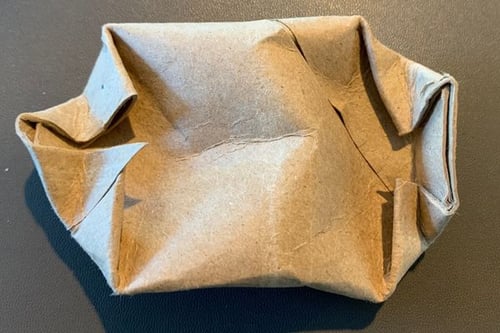
Growing Catnip at Home
 Catnip can easily be grown outdoors or indoors in pots. It is a short-lived perennial, but in ideal conditions, it grows vigorously. It will produce plenty of leaves for drying, but you can use the fresh leaves or let your cat play with the plant itself.
Catnip can easily be grown outdoors or indoors in pots. It is a short-lived perennial, but in ideal conditions, it grows vigorously. It will produce plenty of leaves for drying, but you can use the fresh leaves or let your cat play with the plant itself.
Just make sure to put the plant on a low surface so the pot won't be tipped over and break. You can use sticky putty to secure the plant pot. See our video where we show how useful this putty is in households with plants and cats. We haven't used this museum putty, but it says it will hold up in an earthquake – so, rather appropriate for a cat on catnip!
Growing Catnip Outdoors
- Select a safe planting place where your cats won't be harmed if they roll in the plants.
- Plant in the spring only after the danger of frost has passed.
- If using seeds and not plants, they should ideally be soaked for 12 to 24 hours prior to planting to improve germination.
- Some gardeners recommend freezing the seeds overnight and then soaking them.
- Seeds should be planted a ¼ inch deep into the soil.
- Plants need to be about 18 to 24 inches apart.
- Select a sunny place. They need about 6 hours of direct sunlight a day.
- Select a site with well-drained and nutritious soil.
- Monitor the soil regularly and water when the top inch is dry.
- Encourage the creation of abundant leaves by fertilizing your catnip with water-soluble plant food.
- Leaves or stems can be picked once the plant reaches 6 to 8 inches and is in full flower. Ideally, pick after the dew dries but before the heat of the day.
- After cutting, hang the stems upside down in a dark, dry, and well-ventilated room as soon as possible. Drying usually takes two to three weeks.
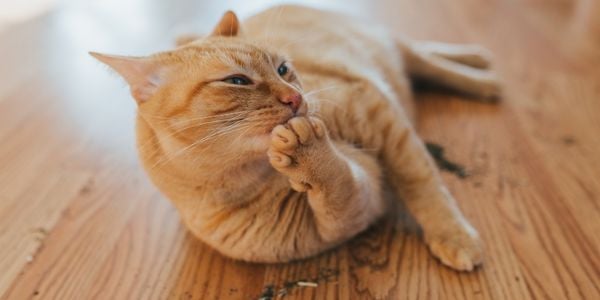
Growing Catnip Indoors
- Select a pot that is at least 12 inches in diameter, no less than 8 inches deep, and has drainage holes.
- TIP: Unglazed pots are best since the walls will allow excess soil moisture to escape.
- Select a well-draining potting mix.
- Plant the catnip that you got from a nursery at the same depth as the container you got it in.
- If planting from seed, follow the seeding instructions above in the "Grow catnip outdoors" section. These catnip seeds are non-GMO and from the USA.
- Since catnip is sensitive to waterlog, only water when the surface soil is dry.
- Be sure it gets at least 6 hours of direct sun per day.
- Catnip tends to prefer temperatures between 55 F and 85 F.
Here's a video that offers great tips for growing catnip at home.
Have you used catnip with your cats? How do they do with it? Have you ever tried growing your own catnip? We’d love to hear about your experiences.




